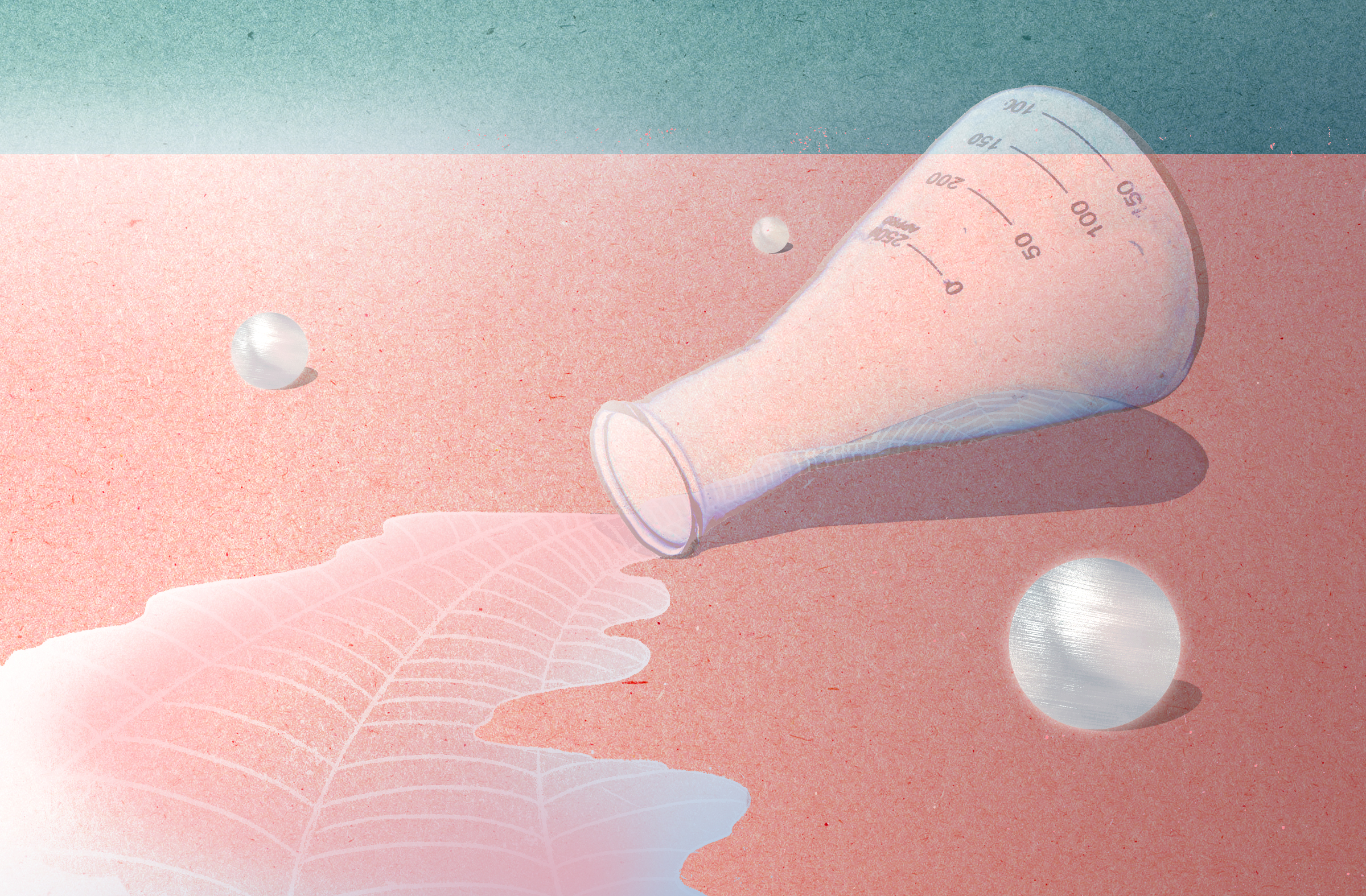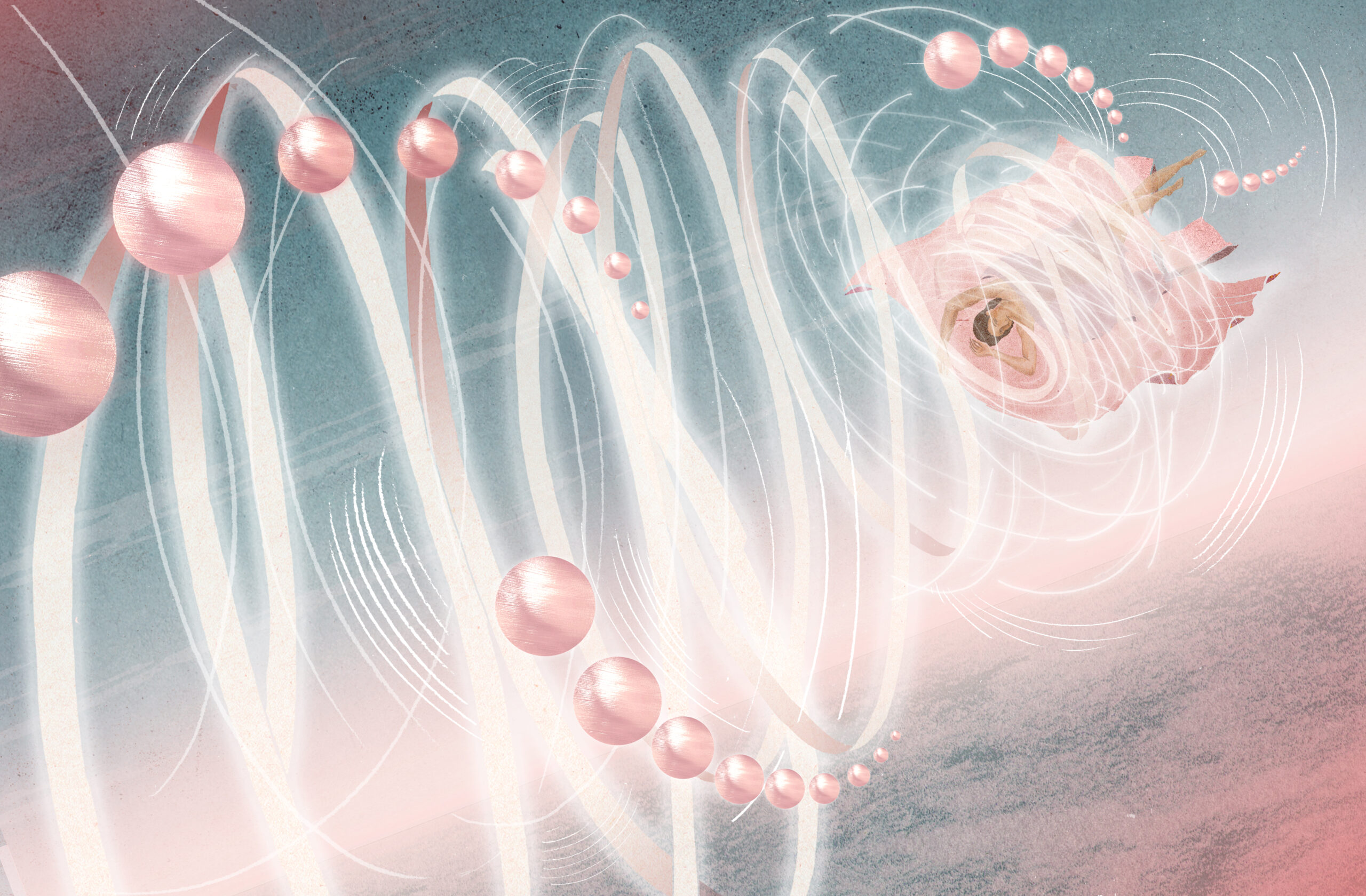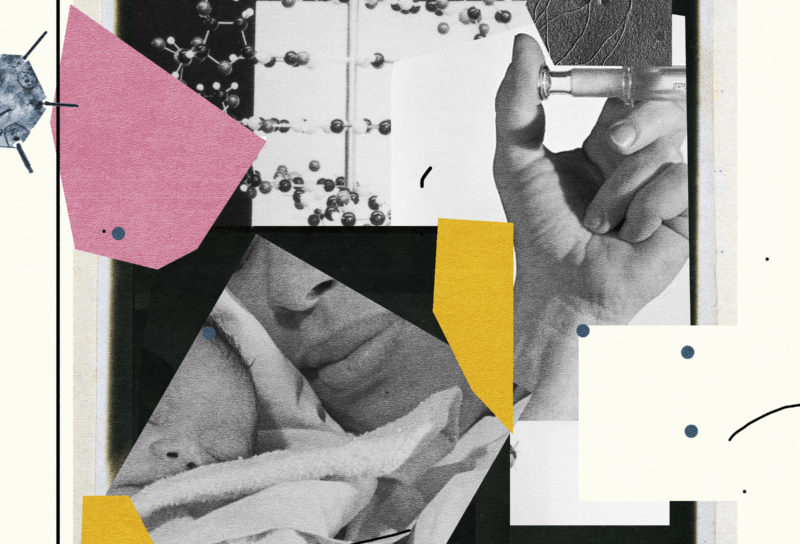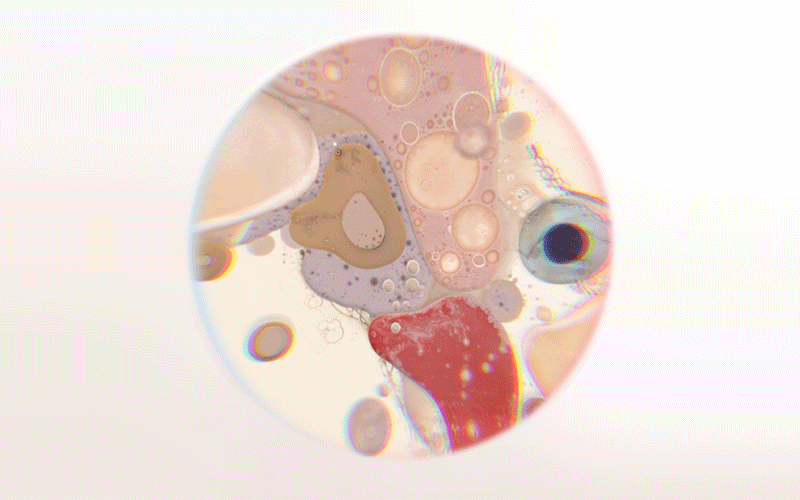bombyx mori isn’t the flashy type. If you came across one of these domesticated moths pinned in a museum display alongside other members of its order, you probably wouldn’t bother stopping. Bombyx is off-white (not quite cream, not quite smoke) with a big fat body, faint brown markings, and feathery antennae. After five millennia of being bred in captivity, adults of this order cannot fly or feed. They rarely get a chance to try either, since most are killed in the larval stage, still wrapped in their soft cocoons. Like lobsters, these moths are boiled alive. The heat melts the bond between their cocoon and their larvae. Soon all that’s left is an empty husk that unspools into a long white fiber, commonly known as silk. How can such a gruesome process elicit something so beautiful?
I’m accustomed to thinking of insects as pests, vectors for disease and competition for tomatoes, but it’s nicer to think of them as our little buddies. They eat us, we eat them. We evolved together. The insects that are sacrificed for silk production have been particularly good to us. Humans around the globe have been using spider silk to dress wounds since the first century CE, and while it’s no longer common, we still use silk to sew together layers of flesh and pieces of organs. The structural compound in silk is compatible with our bodies; our cells don’t immediately classify it as a foreign invader and begin waging war. We can heal around its fibers.
These pale strings helped pull us out of antiquity. The invention of silk streamlined the economic development of the modern world, for it was through the trade of silk that money, knowledge, and power flowed steadily across the largest continent on Earth for over a millennium. The Silk Road shaped today’s maps, borders, even religions. The fabric at its center changed how people dressed, painted, and wrote, inspiring legends, poems, and songs. And it isn’t hard to see why. Silk has a prismatic sheen, a trick of the eye caused by the triangular stacking of its proteins.
I have a silk skirt that shimmers in the light; it is diaphanous, too pretty to wear. It’s absurd to think that its threads were made in the salivary glands of a mulberry-eating larva: that it came out liquid, a slush of protein, and hardened in the air. As I write this, I’m imagining what it would be like to lie on a bed for hours, continually spitting out a viscous fluid that hardens around my body like a big, long pool noodle, turning over and over until I’m all wrapped up and safe, ready to dissolve and grow wings. It’s grotesque, some real Gregor Samsa body horror. And yet, this is how beauty comes into the world, by binding molecules and breaking bonds, gluing and ungluing.
Once beauty has revealed itself, people can’t help but mythologize it. These creation myths gloss over the sacrifices made for beauty, eliding all the glue and goo. There’s one such myth about silk that I particularly enjoy, even though I find it rather unlikely. In this story, we see an emperor’s pampered wife dressed in her daily finery. She’s sitting in the shade cast by the papery leaves of a mulberry tree. She hears a small plink, and looks into her teacup to see an insect. Well, not precisely an insect. It’s a fluffy little something unraveling into her beverage. As she fishes it out, she notices how fine the strange thread is, and how strong. It gives her an idea. She looks up, and there are more silkworm pupae wrapped in softly shining cocoons. She knows just what to do next. She calls her servants. Spin, she says.
We don’t know exactly when silk production began, though we think it could be as early as 8,500 years ago. Historians estimate that it spread from the Chinese empire around 200 BCE. We have some stories about early moth breeders and silk-makers, and objects that tell these stories, like a 1,300-year-old aide-mémoire from Central Asia that currently resides in the permanent collection of the British Museum. It’s a wooden plank painted with four figures. There’s a princess wearing an elaborate headdress, into which she has secreted a pile of silkworms, mulberry seeds, and tools. Nearby, a maid dramatically points to the Silk Princess, calling attention to her ruse, and on her other side, a man sits weaving silk.
This weathered artifact was probably used by a storyteller to help explain to a general audience how such a miraculous invention traveled from one kingdom to another. You see, this wasn’t supposed to happen. China wanted to protect its monopoly on the incredibly lucrative fabric. But like many great discoveries, this one was simply too good to keep under wraps. The scene, which historian Neil MacGregor calls “one of the greatest technology thefts of history,” is presided over by one more figure: the God of Silk, who appears to approve of Princess’ bold fashion choice and its economy-altering effects.
Both of these stories reveal something important about silk: It’s a fabric so intricately tied to wealth and power that — even though it’s farmed, harvested, and spun by lower members of society — we can’t really conceive of them having any impact on its discovery or dissemination. But, of course they did. From the beginning, lower-class women have been the ones harvesting and spinning silk thread. In ancient China, the women who produced the silk weren’t allowed to wear it; the fabric they created was reserved for the upper echelons of society. This changed somewhat during the following 3,000 years, but not as much as you might expect. Silk is still made primarily by poor women who can’t afford to wear it. The history of silk is less a story of constantly changing technologies than a case study on how certain ideas can spread across borders and over oceans. In Japan, silk production took off around 300 BCE and made its way to the Roman Empire just 200 years later. By 1000 CE, there was sericulture in North Africa and Italy. For much of the Middle Ages, Italian silk dominated the European market, but soon, France began to catch up and started producing beautiful textiles of their own. In the early 1600s, even the British were planting mulberry trees with hopes of raising their own silkworms. Soon after, in 1613, ships carrying silkworm larvae and mulberry seeds landed in Virginia, ready to introduce yet another potential pest to the “New World.” Each country put its own spin on the fabric, discovering new ways of weaving, dyeing, and wearing it.
Until its disintegration, the Silk Road continued to play a role in trade, because China remained the world’s top producer of silkworms and raw silk. Plus, it had other amazing discoveries to share with the globe — paper, gunpowder, porcelain. And Europeans have never stopped craving spices from abroad. Some historians argue that it was primarily spices, not silk, that carved those all-important trade routes, but it’s probably a bit late to rename the whole operation now.

Over the centuries, people have tried to create fabrics that could replace or rival silk. The need for a silk substitute was more pressing in some regions than others. Sericulture didn’t take off easily in England, for example, following the planting of 100,000 of the wrong type of mulberry tree. In 19th-century France, two diseases nearly wiped out the country’s population of silkworms, only for disaster to be narrowly averted by one Louis Pasteur.
Instead of bothering with those trees, one scientist began monkeying around with wood pulp. In the 1880s, Count Hilaire de Chardonnet (an assistant to Pasteur) created an artificial silk out of cellulose. This was marketed in the early 1900s as “Chardonnet silk” — or sometimes “mother-in-law silk.” Out of Chardonnet’s discovery came many different forms of synthetic plant-based fabrics, from Tencel to bamboo fiber. Although rayon can be a decent dupe for silk — from a distance, at least — it doesn’t have the same sheen, nor does it drape across the human body in quite the same way.
For its beauty, its symbolic meaning, its medical properties, silk remains. Even so, there are a lot of good reasons one might want to remove insects from the silk-making equation. For starters, we wouldn’t need to boil so many larvae, which would probably be nice for them. There’s also a possibility that we could make other types of insect silk, like spider silk or bee silk. These fabrics are incredibly strong, and when woven and layered correctly, could be used to make bulletproof clothing. We’ve made lots of attempts to farm spiders, but it’s never really worked because spiders are unruly cannibals with an attitude problem. Our loss: Spider silk is even stronger than worm silk and could be used for everything from making better climbing ropes to creating artificial tendons, bones, and other body parts.
There are other good reasons for rethinking this ancient equation. Google “silk industry labor violations” and a painful history unfurls in front of you. There’s a Human Rights Watch report from 2003 that documents years of abuse (including sexual abuse) of enslaved girls in India; there’s a 2020 report from the U.S. Embassy to Uzbekistan that counts “forced labor cultivating silk cocoons” next to “commercial sexual exploitation” as among the “categorical worst forms of child labor.” In America, we tend to think of slavery as a thing of the past, something distant and rare. But there are slaves, right now, working to harvest silk. The end result is a shimmering white nightgown decorated with delicate flowers, part of a bridal set, or perhaps it’s a soft rug, destined to lay on the floor of a nursery for a child named Forrest or Peace or maybe even Mulberry — stranger things have happened.
There is a possibility we could all be wearing mothless, worm-free silk in a few years, thanks to the tools of synthetic biology. Instead of farming larvae and waiting until they spin their cocoons, we could simply take genes out of the silkworm (or even the spider), stick it in another organism, and let that new, modified organism make us some silk. I’m being a bit flippant because this sounds to me like science fiction, but labs and companies have actually been working on this specific problem for decades. Genes can be moved around like puzzle pieces, traded like cards, or, to use a more common metaphor, living things can be programmed to perform new functions. We have made glow-in-the-dark mice and we’ve created purple roses (often marketed as “blue”) by stealing genes from delphiniums and pansies. A yeast or bacterium that produces silk at large scales doesn’t sound too outlandish compared to those psychedelic creations.
Yet there would be a downside, and people would suffer. We would endanger an industry that currently employs over 8 million people in China, India, and Thailand, according to the International Sericulture Commission. Many of these workers live in rural areas, and many of them are women. The ISC claims that sericulture is good because it keeps “the rural population employed” while preventing “migration to big cities.” It also “requires small investments.”
These trade-offs here are beyond my paygrade, but I would care if humans suddenly stopped farming moths to make silk. When we make things by hand, the way ancient people did, we learn something. We’re participating in this big ebb and flow of beauty and creation. Boiling silkworms, hunting deer, harvesting trees — all these practices have an element of brutality and a potential for beauty. They also have alternatives. We can buy lab-grown silk, lab-grown meat, and build our homes using entirely engineered materials. This is more ecofriendly. It may even be considered a tradition in its own right. The modern biology lab, after all, is just a new front in human-driven evolution, drawing on everything that came before. Alternatives don’t have to mean replacements. If there’s one thing we’ve learned, it’s that monoculture is never sustainable.
Perhaps the answer involves farming moths with respect and treating all of the humans who harvest the cocoons with dignity, neither of which is currently happening. All we have now are stories and products. Things of beauty, things that matter, but things that slip from your grip when you try to hold on. They shimmer, and they fade.



